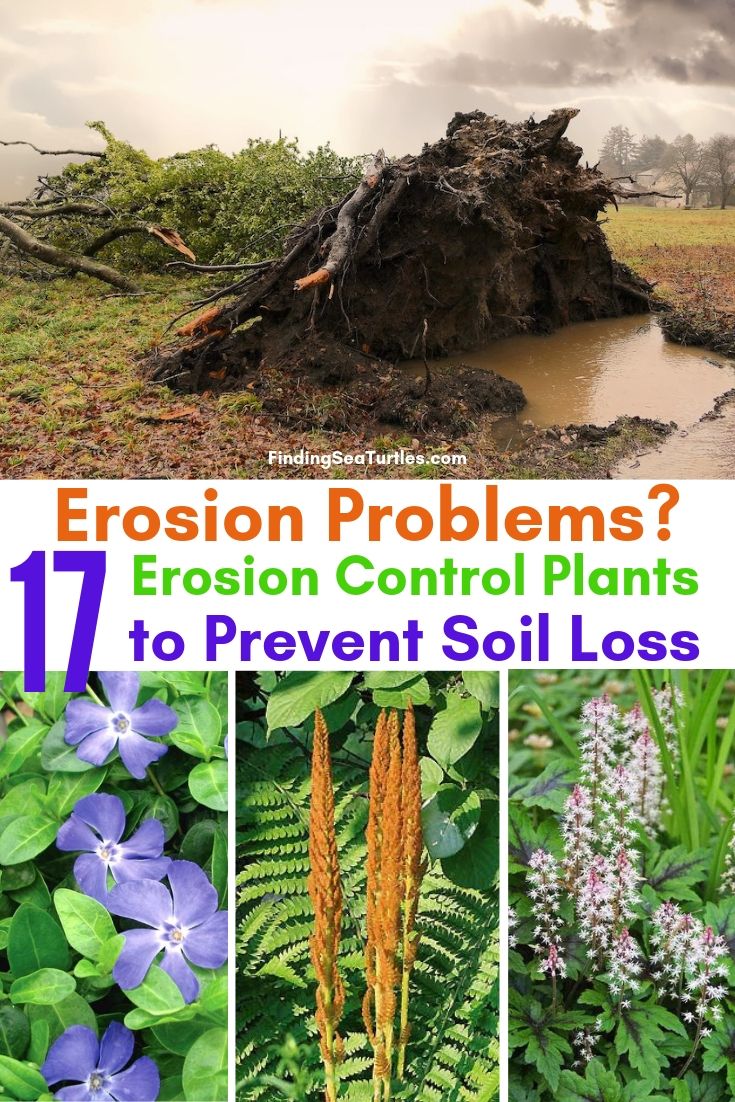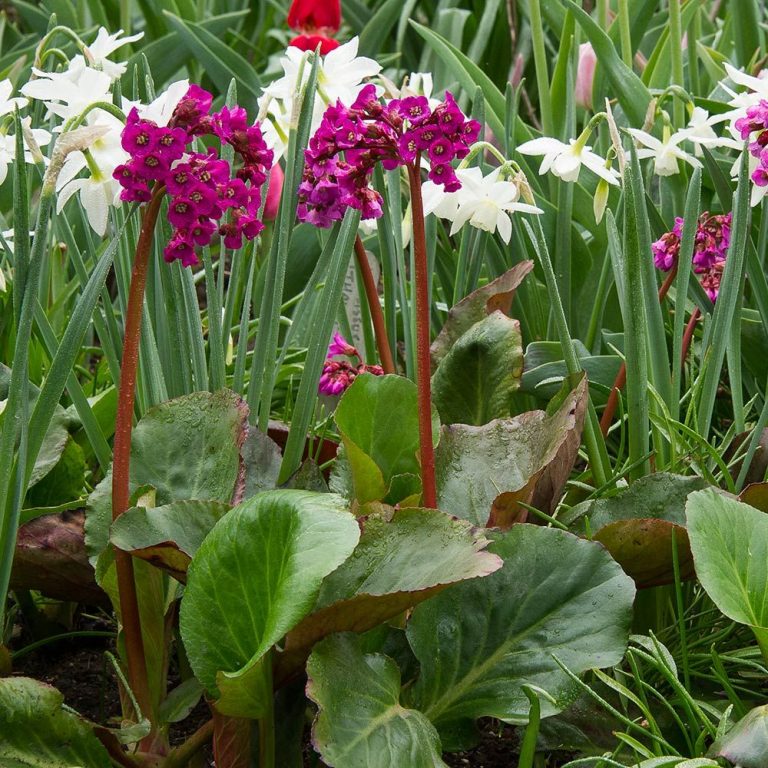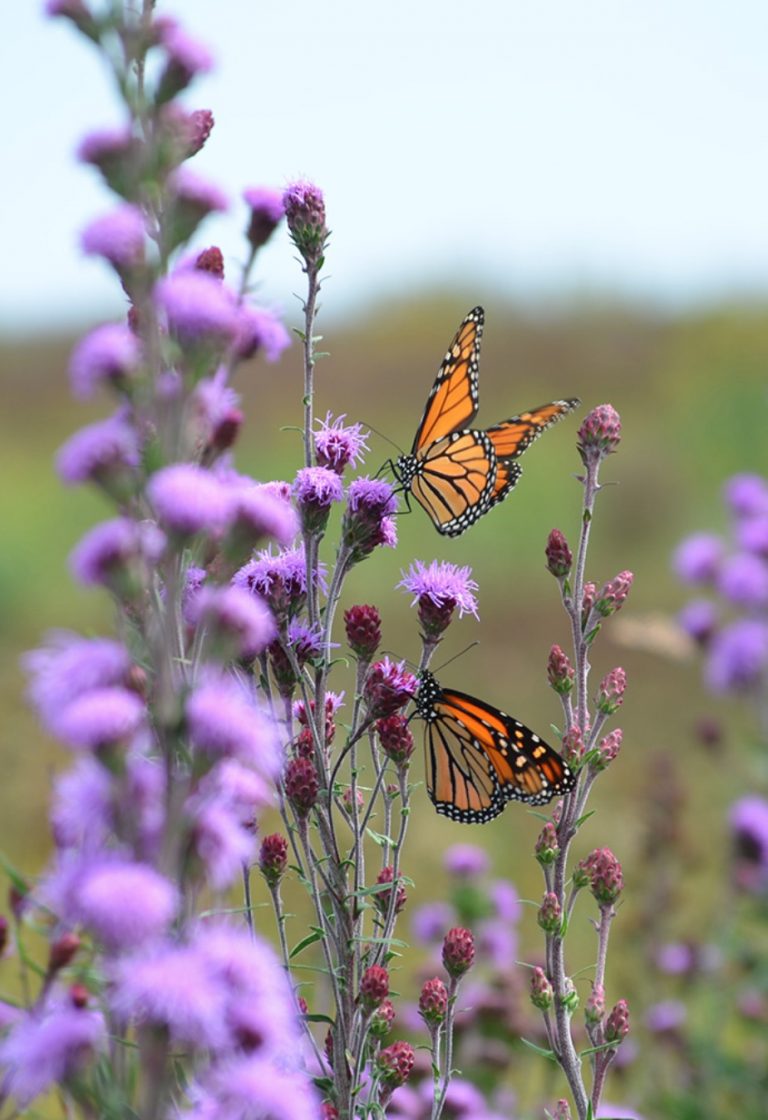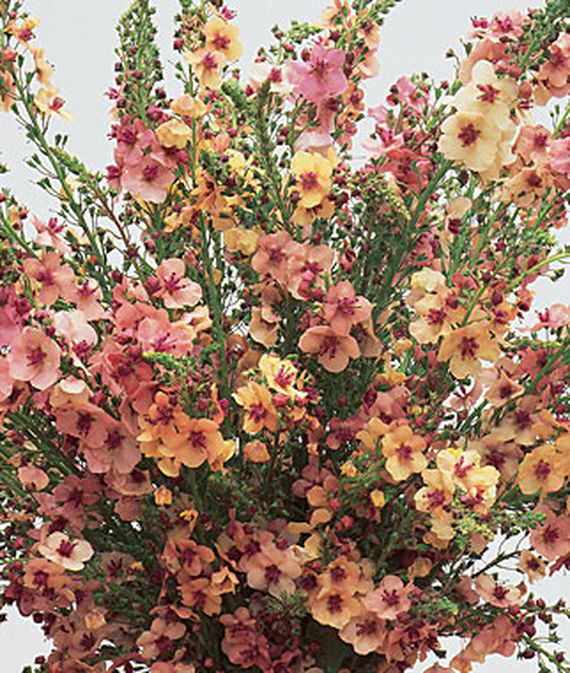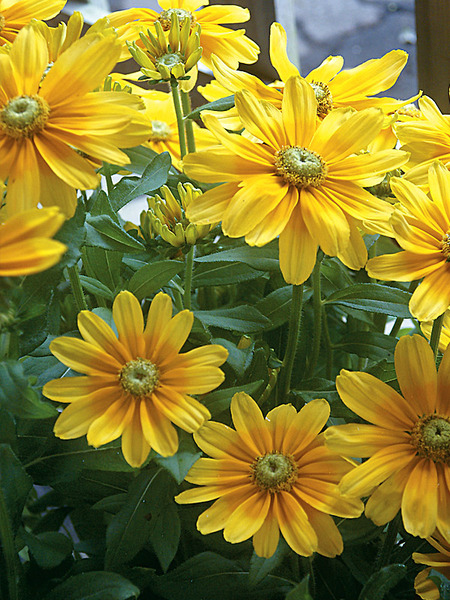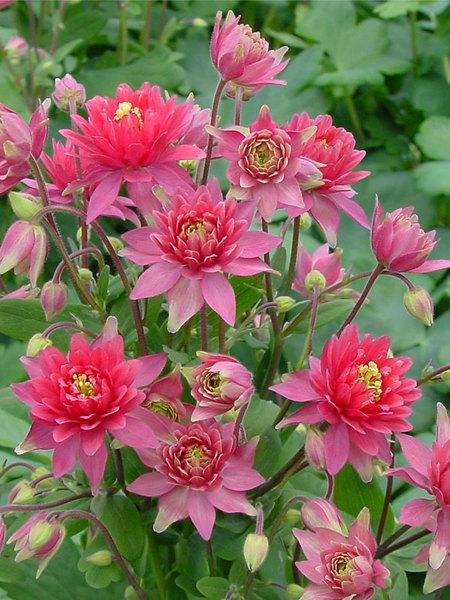Garden Erosion Control Plants for Slopes and Banks
Erosion control plants help retain the landscape soil. Grow erosion control plants to prevent soil loss from surface water runoff. Use tough plants to help the garden maintain its soil and organic material.
Growing the right type of plants aids in garden soil retention. Especially around slopes and banks. Today’s post will review perennials that are effective in controlling soil erosion. And to understand the importance of reducing soil erosion and preventing garden soil from eroding leads to the preservation of the surrounding organic material as well. What is organic material? Organic material comprises lawn clippings, leaves, pine needles, pine cones, and flowers. It is any yard waste that will eventually break down and decompose.
Why is this important? For several reasons. Soil organic matter improves the soil structure. It promotes aeration or air to penetrate the soil. And it allows water to drain down and through the soil or ground. This alleviates soil from compaction. The capacity of soil to hold water and nutrients is greatly improved. Water and nutrients are released over time to aid in plant growth. The result is that soil sticks together to allow microscopic bacteria to decay the nutrients into the soil. Improved plant growth and rich, organic, well-draining soil together provide the conditions to minimize soil erosion.
Erosion Control Methods
Other erosion control methods control soil loss in the garden.
Some methods are more labor-intensive than others. For example. Treating soil compaction issues. Adding mulch or decorative rocks to garden, flower, and shrub beds. Planting grass. Building a retaining wall and improving drainage issues by installing drainage pipes and installing a dry creek bed. These are all valuable methods for controlling erosion. This post focuses on the erosion control method of using perennial plants to prevent soil loss and slope protection. We identify perennial plants that are effective in erosion control in the garden.
Signs of Soil Erosion
You could lose soil through water and wind erosion if your yard is on a slope. Garden soil can become displaced during rainfalls and wind storms. Some signs of erosion are more noticeable than others. You may notice lower ground levels after a visual inspection of the garden. Take a look at the areas around the street. Specifically, the street curb and street drains. Yard waste or mulch on street curbs or around street drains near your home might indicate erosion.
Over heavy periods of rainfall, some yard debris will wash away. Large amounts of soil or yard debris along curbs, street drains, driveways, and sidewalks may be an issue. Exposure to shrubs or tree roots may also indicate erosion.
Clay soil is another cause of erosion. Because clay soil is compacted soil that absorbs little water or rainfall, soil conditions need organic material. The organic material mixed into clay soil will break down the compaction. This leads to better soil structure and soil absorption of water.
Using the right kind of plants helps minimize water runoff. Erosion control plants improve soil conditions. Improved soil conditions lead to better plant health.
Erosion control plants are one alternative to maintaining healthy garden soil. Tackling an erosion problem can be daunting. Using the right type of plants to control soil loss does make a difference.
We’ve rounded up 17 different types of erosion control plants. These plants help prevent soil loss. Take a look. And let us know what you think.
-
Ferns
Christmas Fern
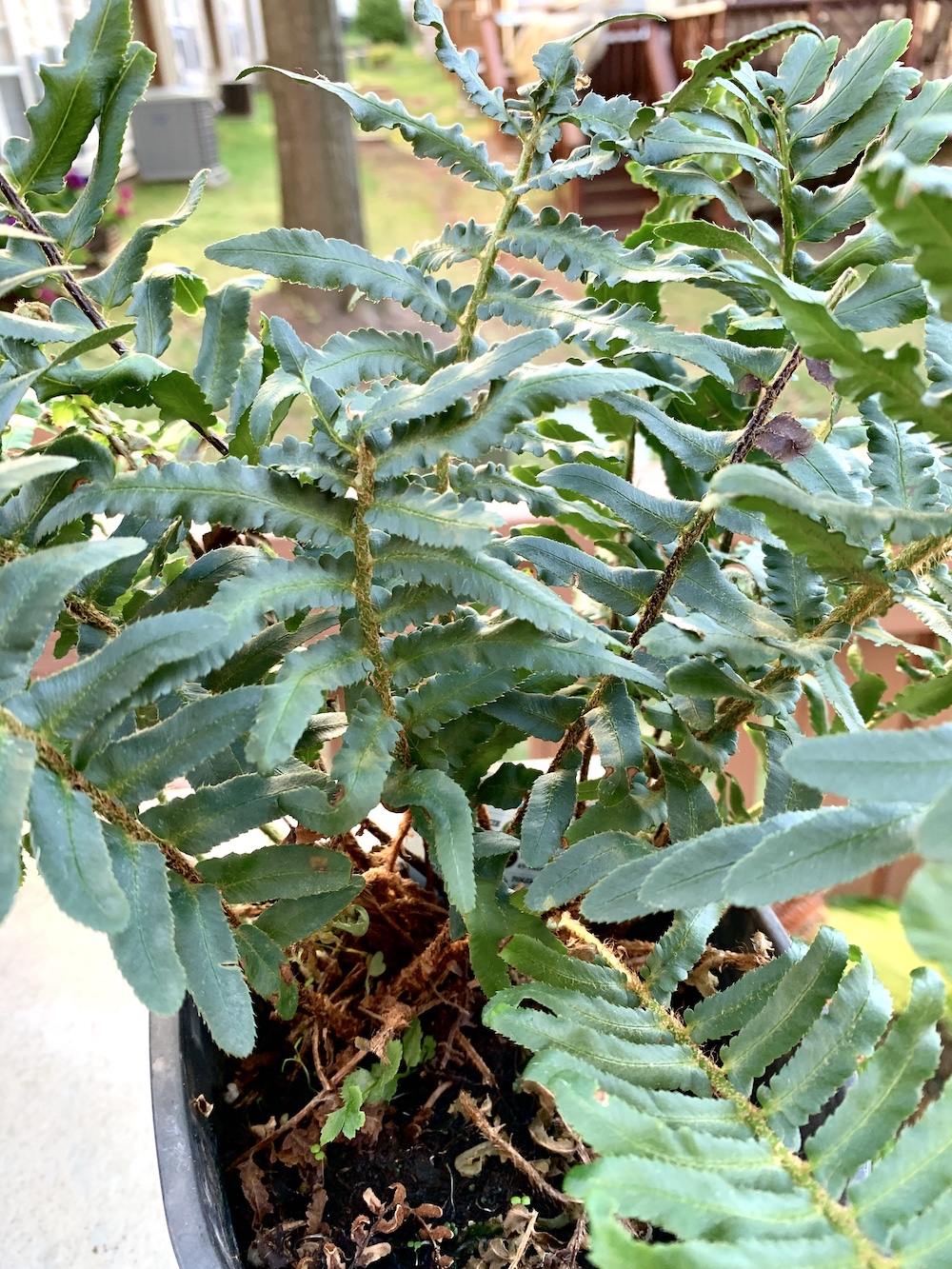
Christmas Fern is also known as Polystichum acrostichoides. Fern foliage is deep, feathery, and evergreen all four seasons. Grows in zones 3 to 9. Likes full shade to part Sun and part shade. Tops out between 12 to 24 inches tall. Spreads about 12 to 24 inches wide. Native of the American woodlands. Deer-resistant and easy-to-grow fern.
Ideal for erosion control on part shade to full-shade garden areas, including slopes. Plant in sandy, loamy, moist or wet, and acidic soil conditions. Likes soil moisture that is average, moist, wet, and well-draining. They were used as holiday decorations years ago. Fronds die back in early Spring. Then fresh new foliage quickly appears. Any remaining dry, older fronds create a mat around the fern. The frond mat protects loose soil from eroding during rainfall. An excellent selection for stream banks or tricky slope areas. Plant as a ground cover or as an accent plant.
Cinnamon Fern
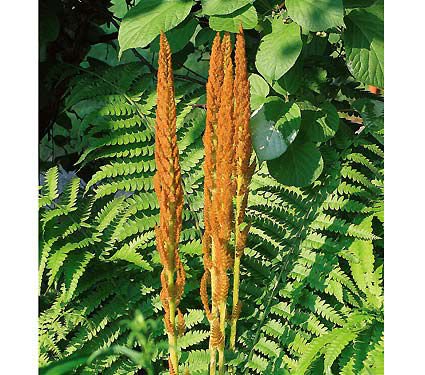
Cinnamon Fern is also known as Osmunda cinnamomea. A native fern with pale green foliage. Foliage darkens. Over the Summer, the foliage turns gold. Then in the Fall, the foliage becomes a rich brown color. Grows in zones 3 to 7. Likes part Sun and part shade to full Sun. Reaches 3 to 5 feet high. Deer resistant. Cinnamon wool on the fronds is used for nesting materials by hummingbirds.
Marginal Woodfern
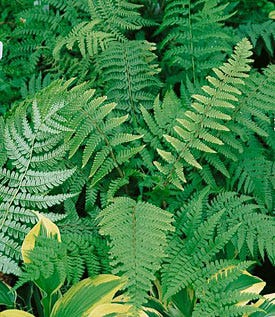
Marginal Woodfern is also known as Dryopteris marginalis. An evergreen fern has rich, blue-green color fronds. Grows in zones 3 to 8. Likes full shade to half Sun and half shade conditions. Reaches 18 to 24 inches tall and wide. Tolerant of poor, rocky, or dry soils. Creates a great ground cover as it spreads and multiplies. Plant in loamy, moist, wet, or acidic soil conditions. Soil moisture conditions average, moist to wet, and well-draining moisture conditions. A native fern. Larger than the Christmas Ferns. Fronds last through frost. The fern fronds emerge like a bouquet.
Lady Fern
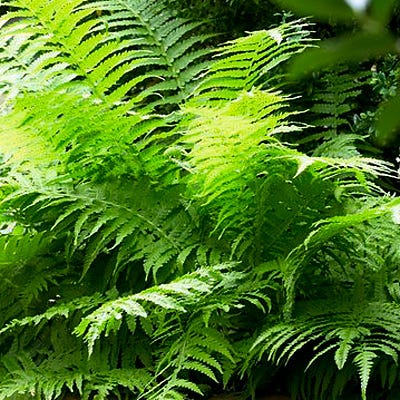
Lady Fern is also known as Athyrium filix-femina. A more miniature woodland fern with finely-cut frilly fronds. Grows in zones 4 to 8. Likes full shade to part Sun and part shade conditions. Reaches 24 to 36 inches tall. Spread is between 12 to 30 inches wide. A native fern. Rabbit resistant. Plant in loamy soil conditions. The best moisture level should be average and well-draining soil moisture. Tolerant of wet sites. Great for woodland, swamp or marsh locations. Poisonous or toxic to animals if ingested.
Sensitive Fern
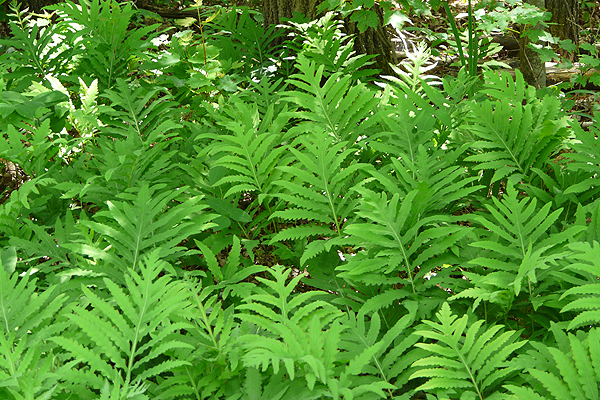
Sensitive Fern is also known as Onoclea sensibilis or Bead Fern. Fern stalks resemble clusters of beads. Blooms June, July, and August. Grows in zones 3 to 9. Likes part Sun and part shade to full Sun. Reaches 2 to 3 feet tall. Plant in clay, loam, or sandy soil conditions. Deer resistant. Spreads aggressively with the right conditions—excellent ground cover for low, moist areas.
Royal Fern
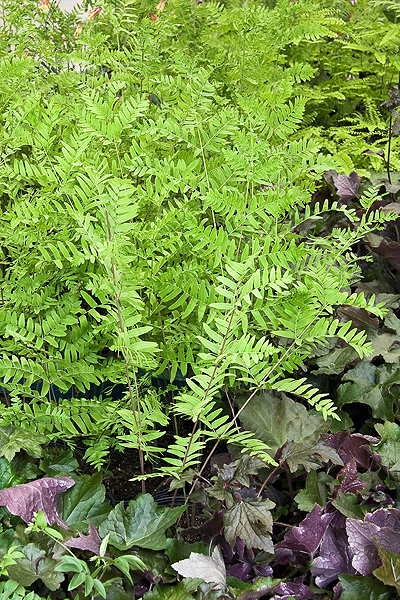
Royal Fern is also known as Osmunda regalis or flowering fern. A larger fern in non-tropical North America. Blooms June, July, and August. Grows in zones 3 to 10. Likes full shade to part Sun and part shade. Reaches 3 to 6 feet tall. Plant in sandy, loamy, or clay soil conditions. Likes moisture levels that are moist or wet soils. Deer resistant. A slower spreading fern. Best in acidic soil. Slower growth in neutral or alkaline soils.
2. Phlox
Wild Blue Phlox
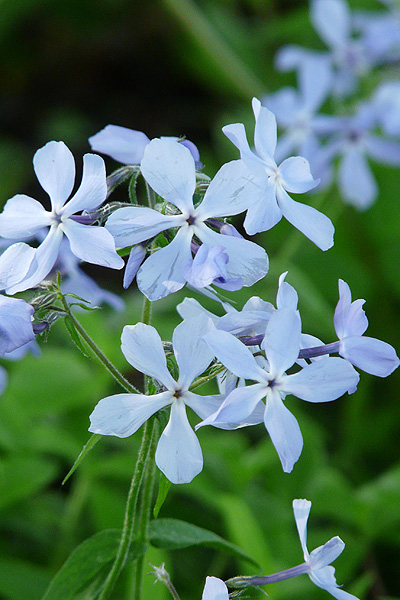
Wild Blue Phlox is also known as Phlox divaricata or Wild Sweet William. Native woodland Wild Blue has fragrant pale lavender to blue flowers. Occasionally flowers are pastel pink or even white—blooms from late Spring to early Summer. Flowers are tubular with five petal lobes. Rounded green fruits follow the blooms. Fruits dry to seed capsules that bear tiny black seeds. Colors attract butterflies, clearwing moths, and hummingbirds.
Grows in zones 3 to 8. Likes full shade to part Sun and part shade. Reaches 1 to 2 feet high. Best in rich, moist, and well-draining soils. Tolerates sandy, loamy, or clay soil conditions. Soil moisture is medium or moist. Once established, tolerant of drought conditions. Attracts pollinators, butterflies, birds, and hummingbirds—plant in native woodland gardens, shady rock gardens, or low borders.
Blue Moon Woodland Phlox

Blue Moon Woodland Phlox is also known as Phlox divaricate. A native phlox ground cover with rich violet-blue flowers above green foliage. Fragrant blooms appear early through late Spring. Grows in zones 3 to 8. Likes full shade to part Sun and part shade. Reaches 8 to 12 inches tall. Spread is 10 to 12 inches wide. Likes loamy, moist to wet soil conditions. Native woodland phlox likes soil moisture that is moist or wet, well-draining soil moisture. Plant in a rock garden or shady area. Beneficial for early season nectar for swallowtail butterflies, hummingbirds, and other pollinators. Plant with Spring blooming bulbs. Provides Winter interest to the garden with its burgundy-colored foliage.
Home Fires Creeping Phlox

Home Fires Creeping Phlox is also known as Phlox stolonifera. Home Fires has masses of fragrant, bright-pink blooms. Foliage is a lush, deep green in the Spring. A native phlox that blooms from late Spring to early Summer. Grows in zones 3 to 8. Likes full shade to part Sun and part shade. Reaches 4 to 6 inches tall. Spreads 18 to 24 inches wide. Home Fires have a fast growth rate. Tolerates sandy, loamy, and moist to wet soil conditions. The best moisture levels are wet and well-draining soil. Forms a dense ground cover. Found in the eastern United States. Blooms provide early-season nectar for butterflies, hummingbirds, and other pollinators. Once established, tolerant of drought conditions. Plant with woodland natives similar to Bloodroot, trillium, or heuchera. Deer and rabbit resistant.
3. Violets
Sweet White Violet
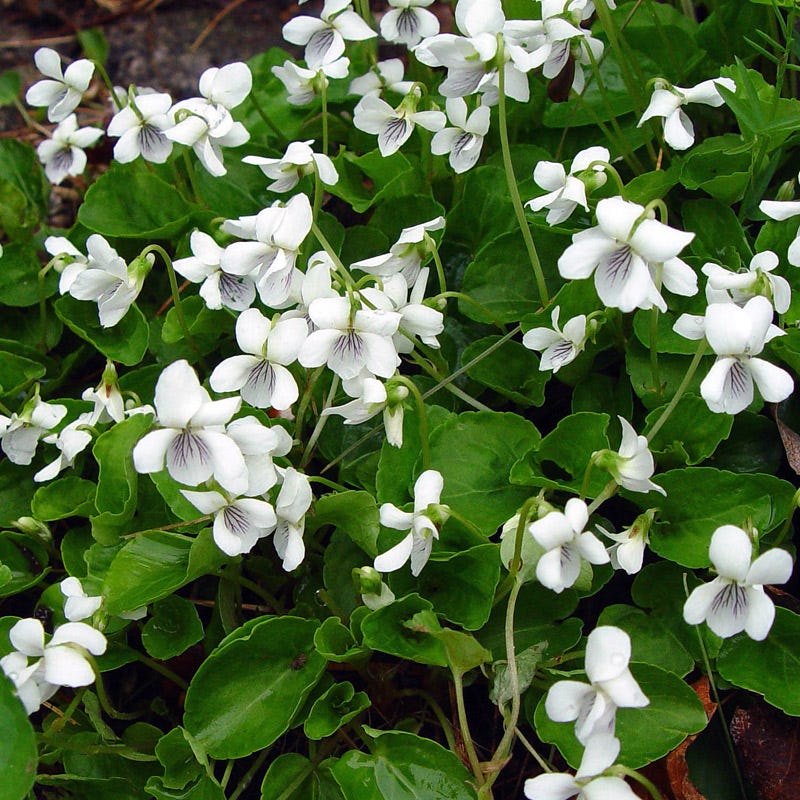
Sweet White Violet is also Viola blanda—a native plant with fragrant white flowers on single stalks. The foliage has deep green, heart-shaped leaves. Blooms mid to late Spring. Grows in zones 3 to 8. Likes full shade to part Sun and part shade conditions. Reaches 3 to 6 inches tall. Spreads 9 to 12 inches wide. Tolerates loamy, moist or wet soil conditions. Moisture levels of average, moist, wet, and well-draining soil moisture. Deer-resistant.
Labrador Violet
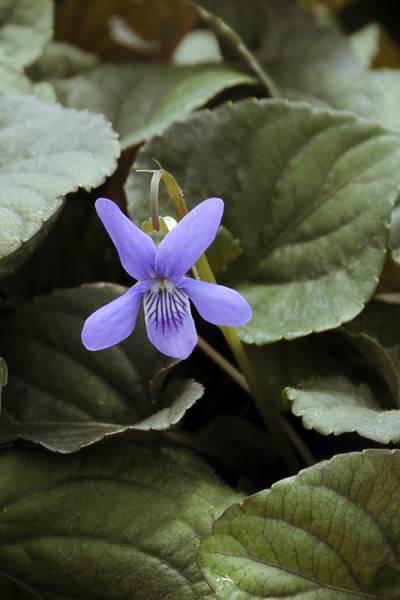
Labrador Violet is also known as Viola labradorica. Labrador Violet has lavender, purple, and blue flowers. Foliage is a dark purple-green color. Blooms in June, July, and August. Grows in zones 3 to 7. Likes part Sun and part shade to full Sun. Reaches 3 to 6 inches tall. Tolerates loamy and sandy soil conditions. Plant as a ground cover. Serves as a host plant for fritillary butterflies.
4. Jack in the Pulpit
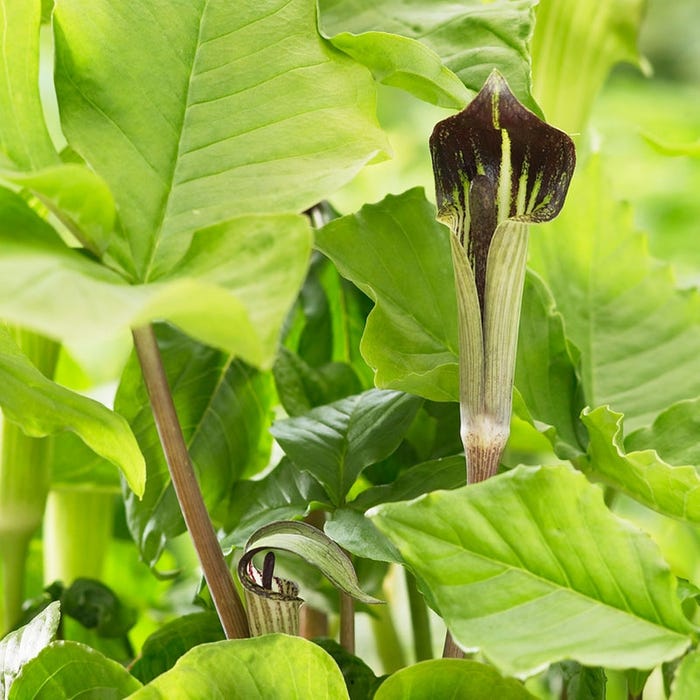
Jack in the Pulpit is also known as Ariseama triphyllum or Cobra Lily. Flowers are hooded green blooms with burgundy striped interiors. The upright spadix is known as the “Jack”. The bloom is about 3 to 5 inches. Foliage is green with three-prong leaves. A vertical cluster of red berries follows the bloom. A native Woodland perennial. Grows in zones 4 to 8. Likes full shade to part Sun and part shade. Reaches 20 to 24 inches tall. Spreads 12 to 18 inches wide. Tolerates loamy, moist and wet, or acidic soil conditions. Moisture level average, moist and wet, well-draining soil moisture. Commonly found in rich woodlands.
5. Virginia Bluebells
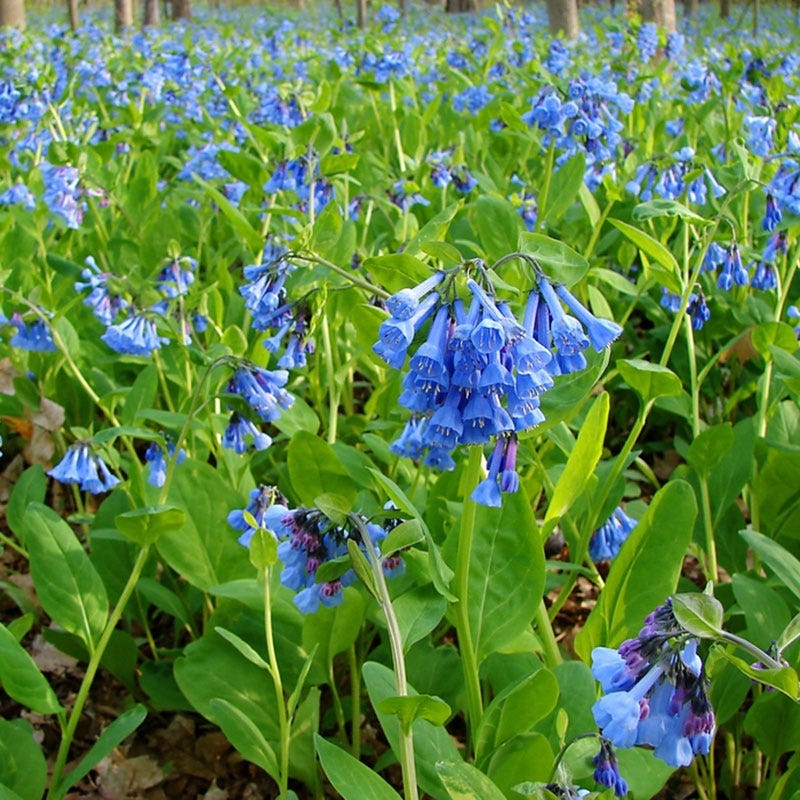
Virginia Bluebells is also known as Mertensia virginica. Bluebells begin as pastel pink buds. Buds turn lavender and then vivid, true blue flowers. Flowers are 1 inch long. Foliage is blue-green in color. A native Woodland perennial. Blooms early through late Spring. Grows in zones 3 to 8. Likes full shade to part Sun and part shade. Reaches 18 to 24 inches tall and wide. Grows in moist to wet soil conditions. Likes moisture levels of average, moist or wet, and well-draining soil moisture. Tolerant of wet sites. Plant in a woodland garden. Beneficial to pollinators during the Spring season.
6. Great Blue Lobelia

Great Blue Lobelia is also known as Lobelia siphilitica or Blue Cardinal Flower. Blooms are light blue. Blooms in July, August, and September. Grows in zones 3 to 9. Likes part Sun and part shade to full Sun. Reaches 1 to 3 feet tall. Tolerates sandy, loamy, or clay soil conditions. Tolerant of damp clay soil. Beneficial to pollinators, butterflies, and hummingbirds. Deer and rabbit resistant. Acts as a host plant.
7. Foamflower
Foamflower Tiarella cordifolia
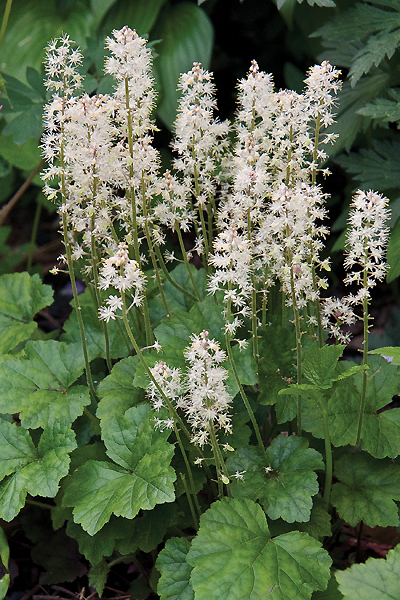
Foamflower is also known as Tiarella cordifolia. Foamflower has white, feathery plumes blooms. Often accented with a light pink. Foliage is a maple leaf shape that remains over the Summer. Foliage turns red in autumn. A showy Spring blooming wildflower. Blooms May to June. Grows in zones 4 to 7. Likes full shade to part Sun and part shade garden conditions. Reaches 1 foot tall. Plant in loamy soil conditions. Likes rich, composted soil. Deer resistant.
Tiarella cordifolia Sugar and Spice
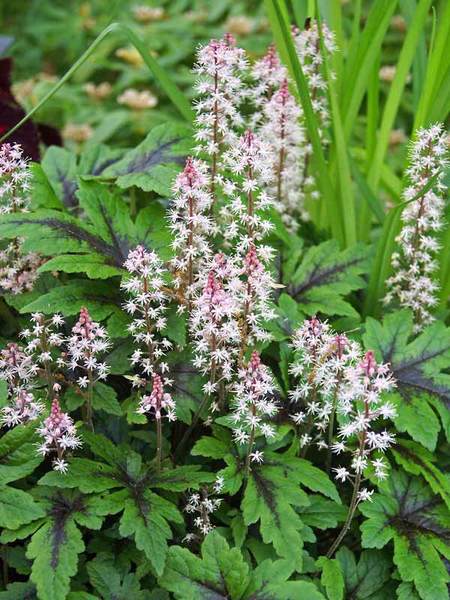
Sugar and Spice Foamflower is a ground cover perennial. Blooms are white airy bottle brush flowers. The flowers buds are rose pink that open to blush white blooms. Foliage is shiny polished lacy leaves with deep crimson markings. Heavy flowering occurs from mid to late Spring. Grows in zones 3 to 8. Likes mostly Sunny to full shade garden conditions. Reaches 10 inches tall. Rabbit resistant. Tolerant of dry shade and shade conditions. Long blooming ground cover.
8. Wild geranium

Wild geranium is also known as Geranium maculatum. Blooms are a lavender color. Foliage is attractive all season long. Blooms May to June. Grows in zones 3 to 8. Likes full shade, part Sun and part shade to full Sun. Reaches 1 to 2 feet tall. Plant in sandy or loamy soil. Beneficial to pollinators. A native Woodland perennial. Best in full shade. Tolerates full Sun with rich and consistently damp soil conditions.
9. Boneset
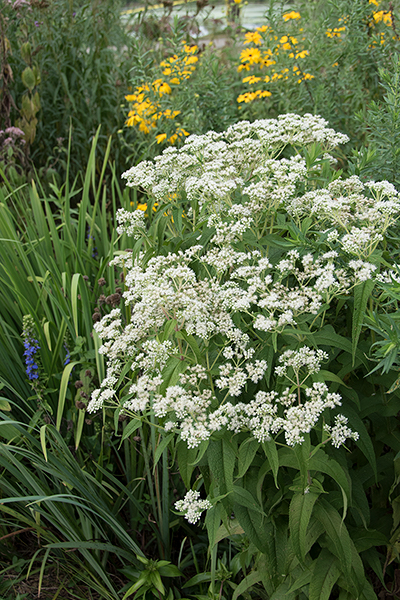
Boneset is also known as Eupatorium perfoliatum or common boneset. Common boneset has pure white blooms. Blooms in August and September. Grows in zones 3 to 8. Plant in full Sun to light shade conditions. Reaches 3 to 4 feet tall. Tolerates sandy, loamy, or clay soil conditions. Best in rich, moist soil conditions. Deer & rabbit resistant. Beneficial for pollinators, bees, and butterflies. Serves as a host plant. Attracts caterpillars from several moth species.
10. Golden Groundsel

Golden Groundsel is known by several other names. Known as Golden ragwort, Packera aurea. And as Common Groundsel, Butterweed, Senecio aureus and Senecio gracilis. Golden Groundsel has yellow flowers. Showy foliage with dense rosettes of heart-shaped leaves with purple undersides. A long and profuse blooming perennial. Blooms in May and June. Grows in zones 3 to 9. Likes full Sun, part Sun, and part shade to full shade garden conditions. Reaches 1 to 2 feet tall. Tolerates sandy, loamy, and clay soil conditions. Likes soil with consistent moisture. Beneficial for pollinators. Attracts small bees such as little carpenters, cuckoos, and various Halictid Bees. It spreads by rhizome and forms a colony. The colony suppresses weeds. Deer resistant. Plant in a woodland garden, along streams or ponds. Include a water feature or rain garden.
11. American Alum Root
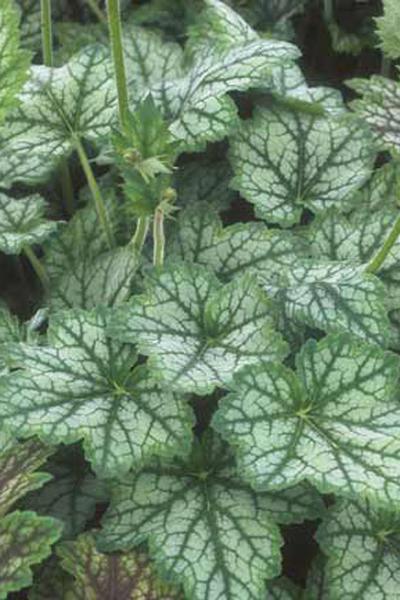
American Alum Root has unique foliage. Leaves are ruffled with silver and red-purple highlights that deliver year-round garden interest. Blooms in June and July. Grows in zones 4 to 8. Likes part Sun and part shade to full Sun garden conditions. Reaches 1 to 3 feet tall. Tolerates loamy or sandy soil conditions.
12. Wild Ginger
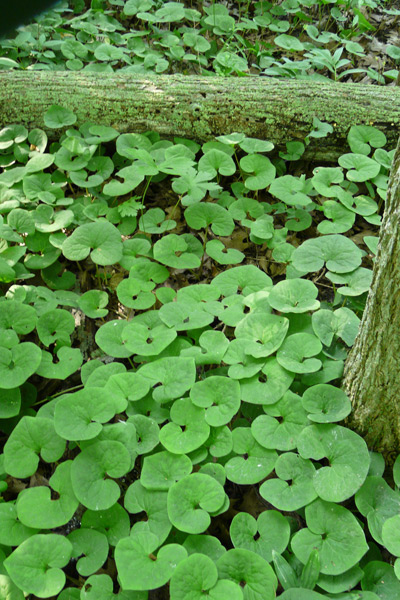
Wild Ginger is known as Asarum canadense or Woodland Ginger. It is also known as Canada Ginger, Colic Root, Coltsfoot, Indian Ginger, Namepin, and Sturgeon Potato. Flower is an attractive dark red flower. The flower is usually hidden by foliage and fades very quickly. The foliage has large heart-shaped leaves, some 6 inches in diameter. Its root system creates a dense network. This creeps and forms a solid ground cover. Blooms in May and June. Grows in zones 3 to 8. Likes full shade to part Sun and part shade garden conditions. Reaches 1 foot tall. Tolerates sandy, loamy, or clay soil conditions. Deer resistant. A woodland native ground cover. Plant with other natives such as Lady Fern, Jacob’s Ladder, or Wild Blue Phlox.
13. Joe Pye Weed
Tall Joe Pye Weed
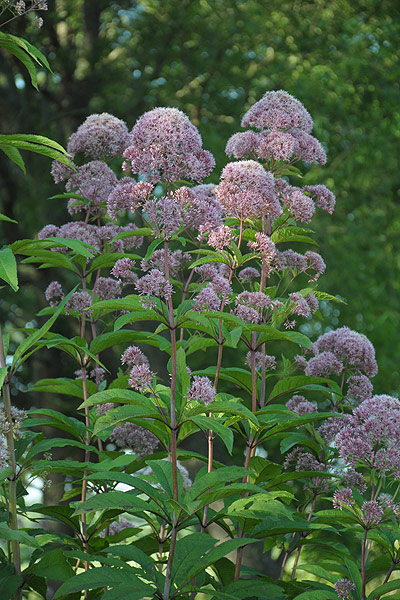
Tall Joe Pye Weed is also known as Eupatorium fistulosum and Spotted Joe Pye Weed. Blooms are clusters of bright pink and purple colors. Blooms in August and September. Grows in zones 4 to 9. Plant in part Sun and part shade to full Sun garden conditions. Reaches 5 to 8 feet tall. Tolerates sandy, loamy, or clay soil conditions. Beneficial for pollinators, butterflies and serves as a host plant. Plant in damp soil in marshy areas, along stream banks, and the edges of ponds.
Baby Joe Dwarf Pye Weed
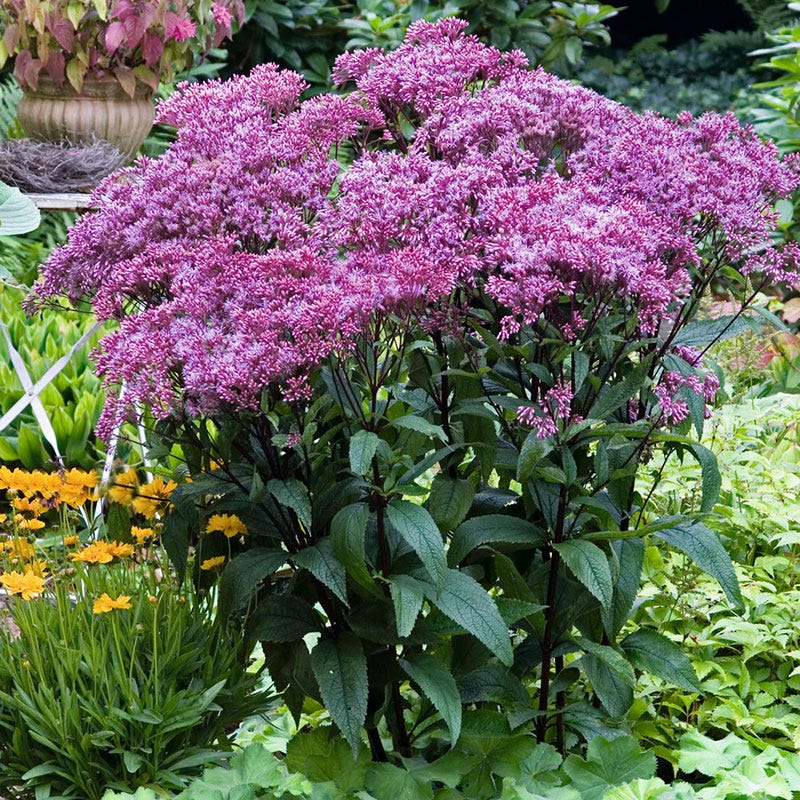
Baby Joe Dwarf Pye Weed is also known as Eupatorium dubium. Baby Joe Dwarf Pye Weed is a native perennial. Blooms are hydrangea-like purple to lavender flowers. Flowers are 4 to 7 inches long. Fragrant blooms appear from mid to late Summer and into the Fall. Forms an upright bushy mound of dark green leaves. Grows in zones 4 to 8. Likes part Sun and part shade to full Sun garden conditions. Compact and tops out between 24 to 36 inches tall. Attracts bees, butterflies, and hummingbirds with vital nectar. Plant in loamy, moist to wet soil conditions. Tolerates wet sites and salt conditions. Ideal for small-space gardening. Deer resistant.
14. Vinca
Vinca minor Bowles
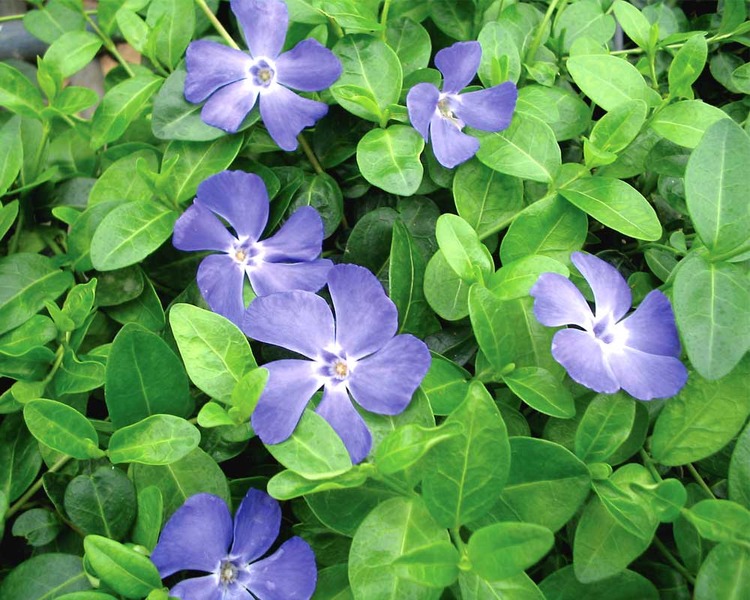
Vinca minor Bowles is also known as Periwinkle or Myrtle—an evergreen ground cover. Blooms are a deep, blue-lavender color. Foliage is glossy dark green with darkly veined leaves. Roots form from its vining offshoots. Creates a dense, vigorously spreading carpet. Blooms late Spring to mid Summer. Grows in zones 3 to 9. Likes mostly Sunny to full shade garden conditions. Tops out at 6 inches. Tolerates normal, clay, or sandy soil conditions. Plant on a slope or bank. Deer resistant. Tolerates dry shade and shade conditions. Good for bank stabilization and erosion control.
NOTE: In some regions, vinca evergreen ground cover can escape into the woods. Vinca is considered invasive in some geographical areas. Check with your local nursery before planting in your area. Plant responsibly.
Vinca minor Sterling Silver

Vinca minor Sterling Silver is also known as Periwinkle and Myrtle. The flowers are a bold blue. Foliage is deep green-edged in cream. Blooms late Spring to mid Summer. Grows in zones 3 to 9. Likes mostly Sunny to full shade garden conditions. Tops out at 6 inches. Tolerates normal, sandy, or clay soil conditions—plant on a slope or bank. Evergreen ground cover. Deer and rabbit resistant. Tolerant dry shade and shade conditions. Excellent for bank stabilization and erosion control.
NOTE: In some regions, vinca evergreen ground cover can escape into the woods. Vinca is considered invasive in some geographical areas. Check with your local nursery before planting in your area. Plant responsibly.
15. Daylilies
Rainbow Rhythm Going Bananas Daylily
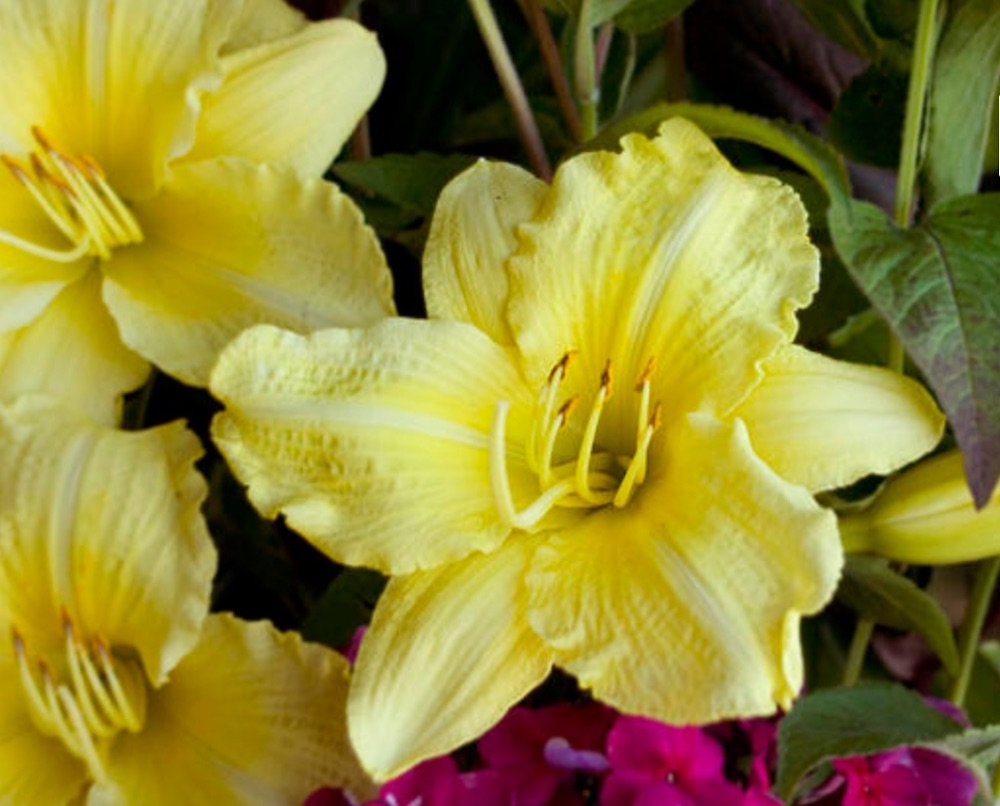
Rainbow Rhythm Going Bananas Daylily, a Hemerocallis hybrid, is a repeat bloomer. Lightly fragrant, lemon yellow blooms. A mounding growth habit. Blooms from early to late Summer. Grows in zones 3 to 9. Likes part Sun and part shade to full Sun. Tops out between 19 to 22 inches tall. Tolerates sandy, loamy, or clay soil conditions. Ideal for mass plants. Low maintenance perennial. Provides Fall interest in the garden. Tolerant of salt conditions. Provides erosion control.
Rainbow Rhythm Primal Scream Daylily
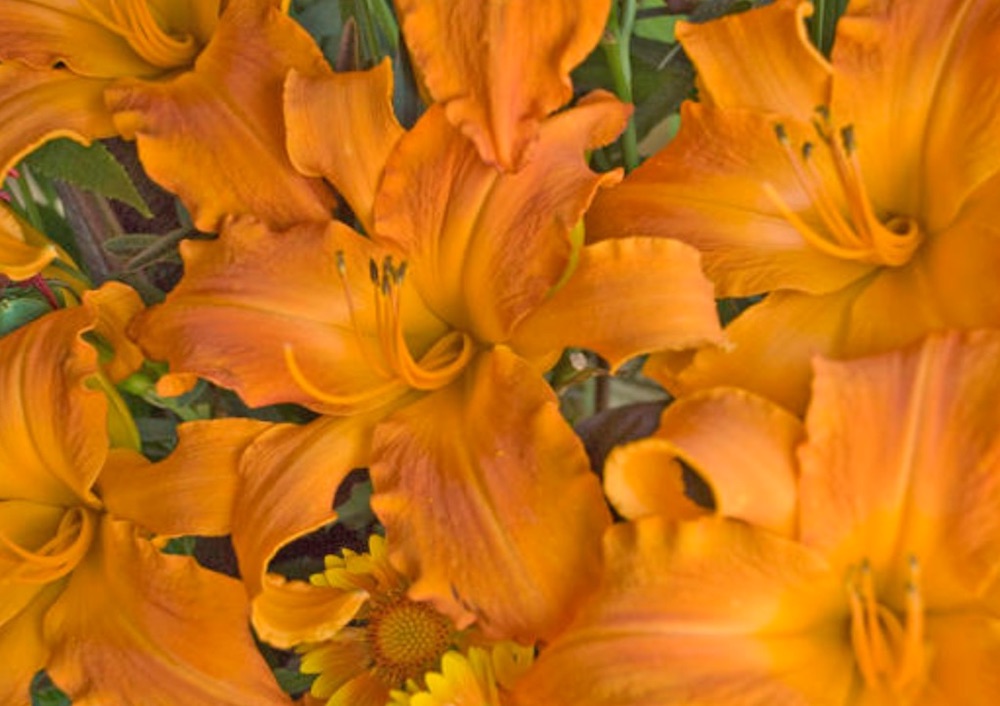
Rainbow Rhythm Primal Scream Daylily, a Hemerocallis hybrid, has large, tangerine orange blossoms. Petals are narrow and twisted, adding to the distinct look. Blooms in late Summer. Grows in zones 3 to 9. Likes part Sun and part shade to full Sun. Reaches 34 inches tall. Attracts hummingbirds. Tolerant of salt conditions. Provides erosion control—Tolerates sandy, loamy, or clay soil conditions.
Rainbow Rhythm Nosferatu Daylily
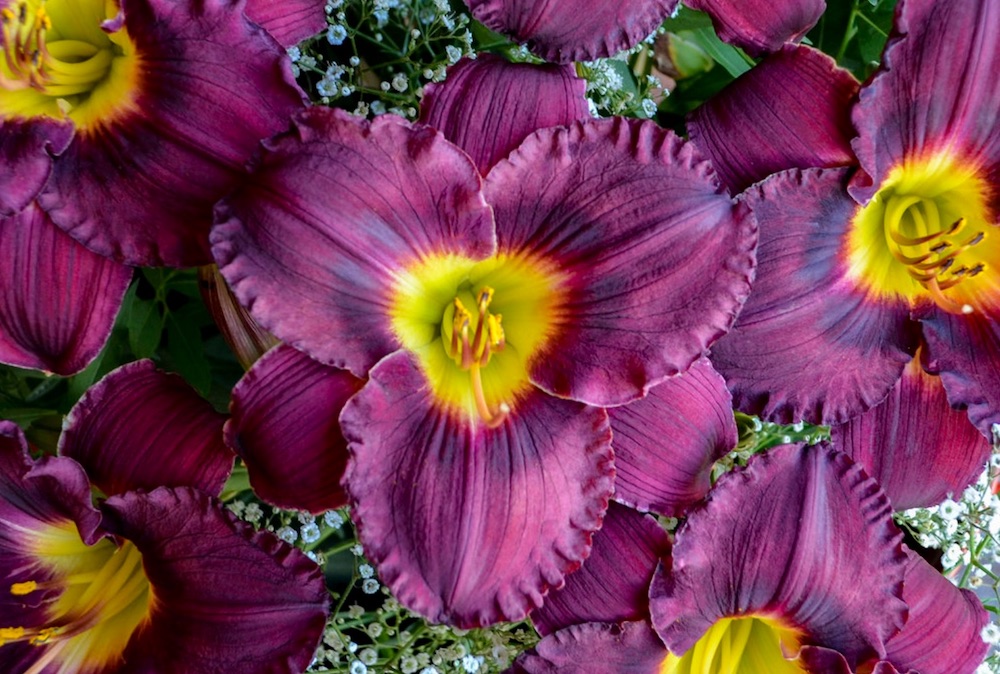
Rainbow Rhythm Nosferatu Daylily is a hemerocallis hybrid. Nosferatu has fragrant, shimmering dark purple flowers with a chartreuse throat. The 6-inch fragrant blooms have ruffled petals. Blooms mid-Summer. Grows in zones 3 to 9. Likes part Sun and part shade to full Sun. Reaches 26 inches tall. Tolerates sandy, loamy, or clay soil conditions. Tolerant of salt conditions. Provides erosion control.
16. Grasses
Cheyenne Sky Panicum virgatum

Cheyenne Sky Panicum virgatum is also called Red Switch Grass and Panic Grass. Cheyenne Sky emerges blue-green in color. Then it turns wine red in early Summer. The flower panicles are wine-red. Blooms mid to late Summer. Grows in zones 4 to 9. Likes part Sun and part shade to full Sun garden conditions. It reaches 2 feet tall and 3 feet tall with blooms. Tolerates normal, sandy, or acidic soil conditions. Deer resistant. Beneficial for wildlife habitat. Provides shelter and food for songbirds. Tolerates humidity and seaside salt conditions. Tolerant of juglone in Black Walnut trees. Great for hedges. Plant in containers, mass plantings, or as a specimen. Perfect for stabilizing slopes that tend to experience erosion.
Sweet Flag
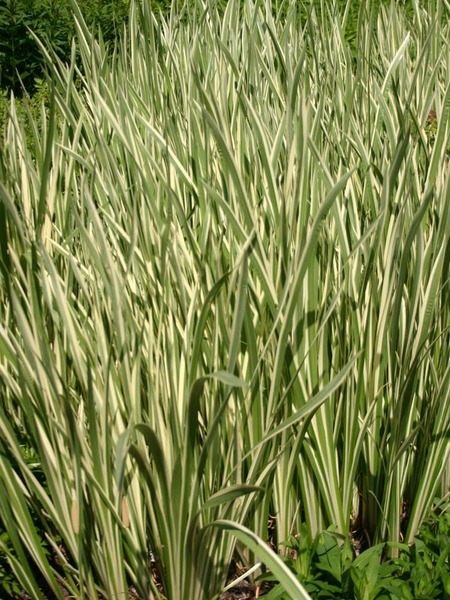
Sweet Flag is also known as Acorus gramineus Variegatus. Foliage is sweetly scented and striped with buttery white and green blades. The flowers are yellow. Tiny berries form in early Summer. Grows in zones 5 to 8. Likes part Sun and part shade to full Sun conditions. Reaches 6 to 12 inches tall. Tolerant of sandy, normal, acidic, or clay soil conditions. Deer and rabbit resistant. Plant on a slope or bank. Use as an edger or ground cover. Tolerates wet sites. Grows well in boggy and moist garden soils. Clumping habit growth with grass-like foliage. Ground cover for soggy areas, rain gardens, or areas with standing water. Provides erosion control along streams and banks.
Cloud Nine Panicum virgatum

Cloud Nine Panicum virgatum is also known as Switch Grass or Panic Grass. Flowers are rose-colored. Blooms mid to late Summer. Seed panicles and foliage become a golden tone in the Fall. Grows in zones 4 to 9. Likes part Sun and part shade to full Sun conditions. Reaches 5 to 7 feet tall. Tolerates normal or clay soil conditions. Beneficial for birds. Deer resistant. Use as a hedge. Provides Winter interest to the garden. Tolerant of humidity and seaside salt garden conditions. Juglone was tolerant around Black Walnut trees. Perfect for stabilizing slopes that tend to experience erosion.
Prairie Winds ‘Totem Pole’ Panicum virgatum
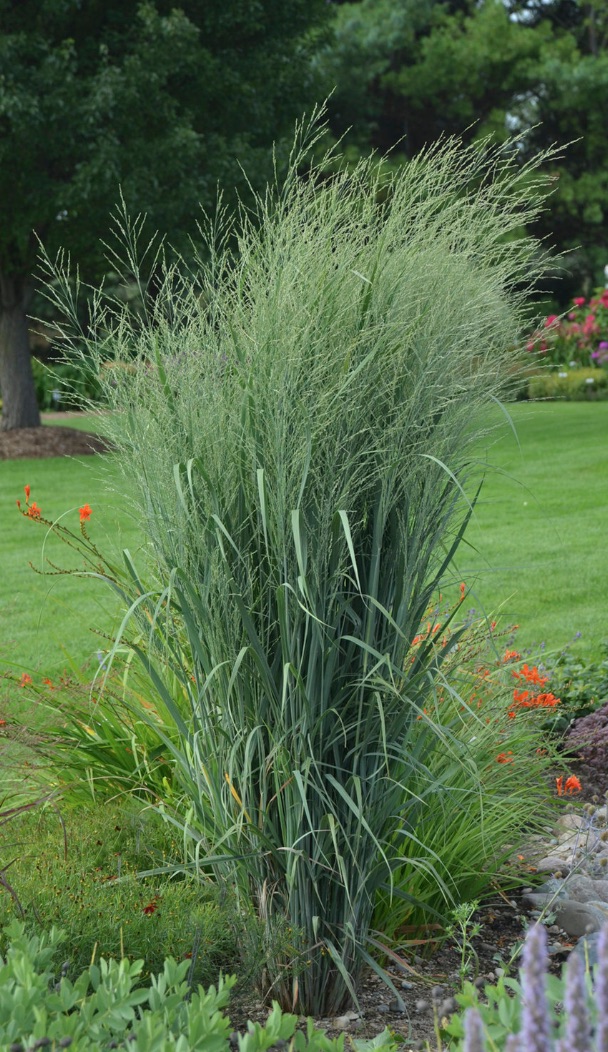
Prairie Winds ‘Totem Pole’ Panicum virgatum is also known as Switch Grass—a North American native. The flowers are golden and yellow. Blooms late Summer to mid-Fall. Upright mounding growth. Foliage is blue-green to steel blue color. Develops golden seed heads in the Fall. Grows in zones 4 to 9. Likes full Sun garden conditions. Reaches 70 to 72 inches tall. Deer resistant. Tolerant of sandy and clay soil conditions. Provides strong foliage interest. Delivers excellent Fall and Winter interest in the garden. Tolerates salt or drought conditions—aids in controlling soil erosion.
Prairie Winds Desert Plains Fountain Grass

Prairie Winds Desert Plains Fountain Grass has showy bottlebrush flowers. Flowers emerge as dusky purple. Then age to a tan color. Foliage turns red, orange, and gold tones in the Fall. Blooms early through late Fall. Grows in zones 5 to 9. Likes full Sun garden conditions. Reaches 40 to 48 inches tall. Likes rich, well-draining soil. Deer resistant. Plant in containers. Create a focal point in the garden with Desert Plains. Great foliage interest. Delivers Fall and Winter interest in the garden. Provides control of soil erosion.
17. Irises
Variegated Sweet Iris
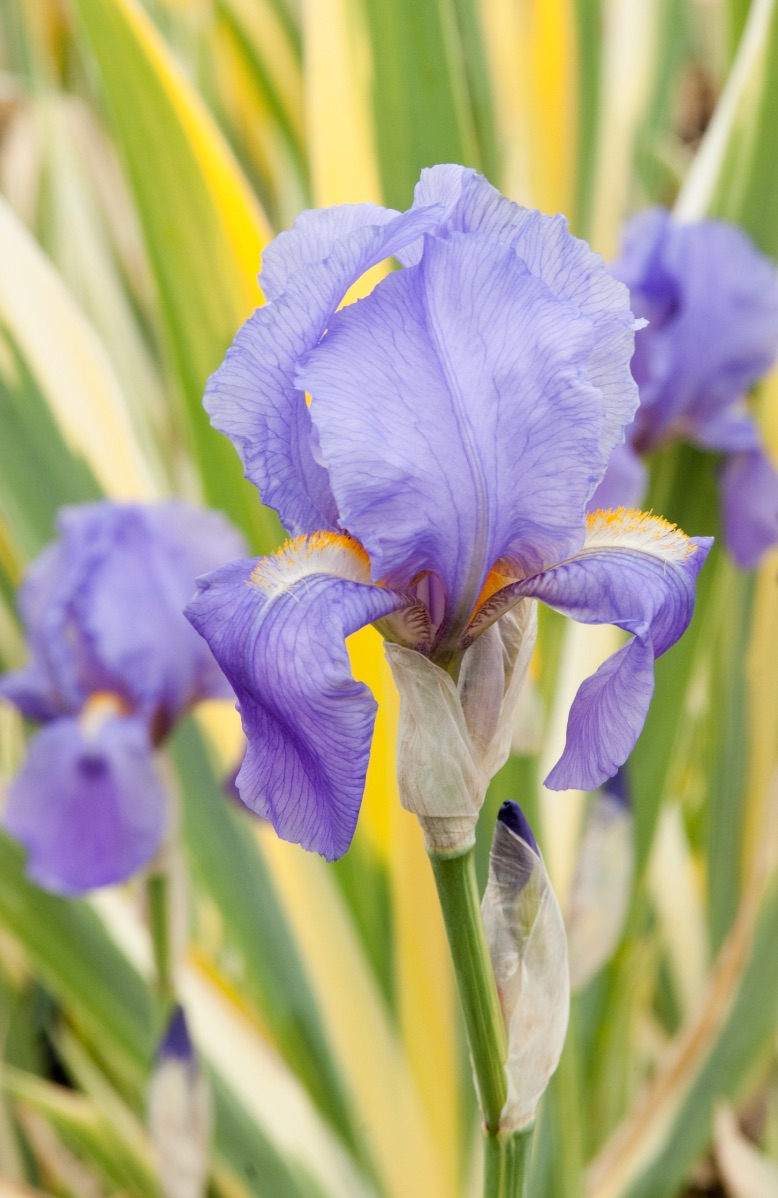
Variegated Sweet Iris is also known as Iris pallida ‘Variegata’. Sweet Iris has showy, fragrant flowers. Flowers are lavender-blue bearded. Foliage is green and golden-striped, brightening the garden. Grows in zones 4 to 9. Likes part Sun and part shade to full Sun garden conditions. Reaches 2 feet tall. Herbaceous perennial. Likes rich, evenly moist, well-draining soil conditions. Water regularly to establish the root system. Grow in garden borders or cut garden. Plant in woodland or rock gardens. Provides erosion control.
Variegated Japanese Water Iris
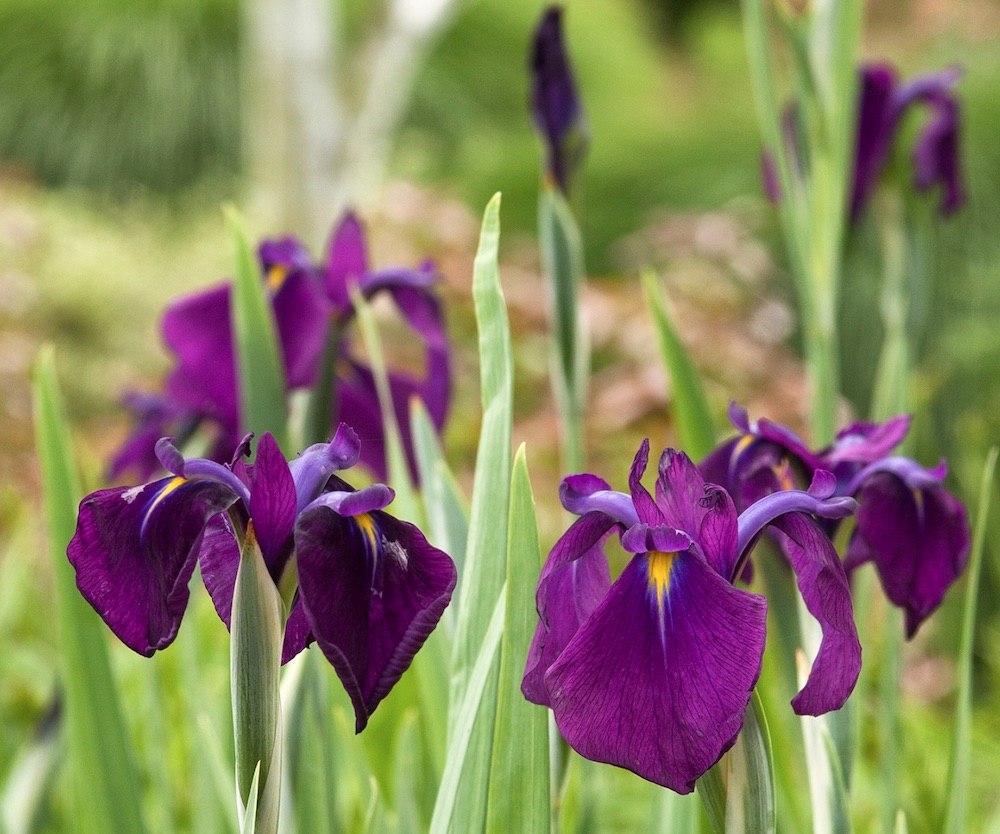
Variegated Japanese Water Iris is also known as Iris ensata ‘Variegata’. Water Iris has showy Summer blue flowers. Blooms in early to mid Summer. Moderate growth rate. Variegated fan-shaped foliage. Herbaceous perennial. Grows in zones 4 to 8. Likes part Sun and part shade to full Sun. Reaches 2 feet tall and wide. Ideal in moist borders, areas around ponds or streams, and water gardens. Plant in containers. Grows well in wet garden areas or low, soggy grounds. Dramatic foliage interest. Provides erosion control.
These are just a few of the erosion control plants available. Many are easy to grow. And incredibly attractive plants. Plant these perennials to retain garden soil. And keep the rich organic material in your yard and not on the street.
Interested in gardening? If you found this helpful . . .
You may also enjoy some of our other gardening-related posts.
Grow Elephant Ears for a Tropical Garden Look
21 Best Ferns for Your Garden
20 Best Hostas for Shade Garden Areas
19 Easy to Grow Coral Bells for Colorful Gardens
Let us know how you make out if you try any of these erosion control plants. And if you have any questions, feel free to contact us. We always are ready to help you out. Thank you for stopping by.
Mary




